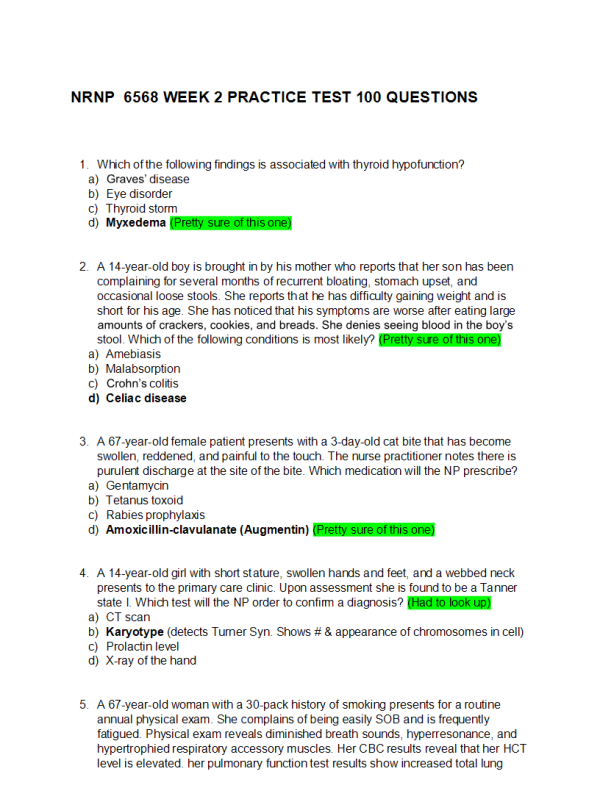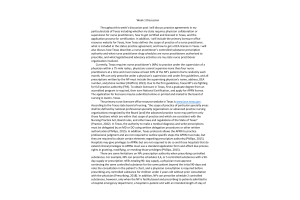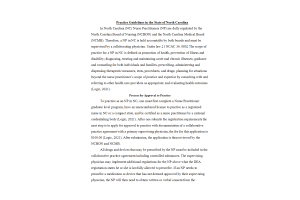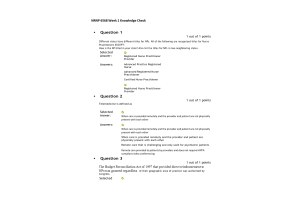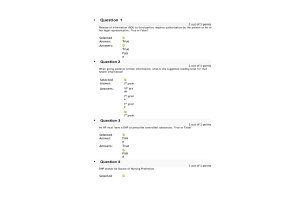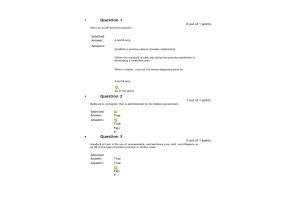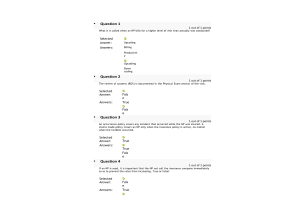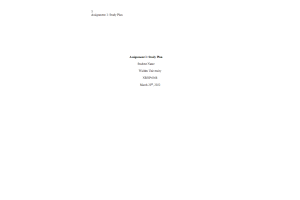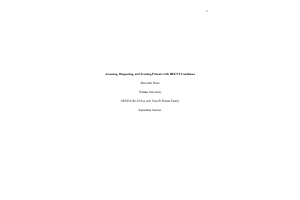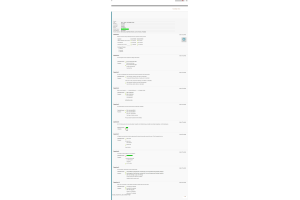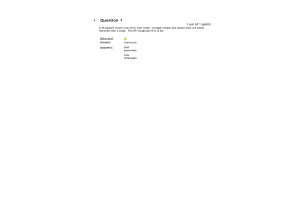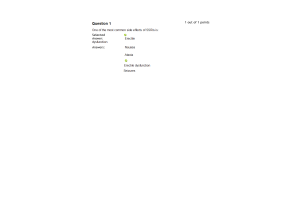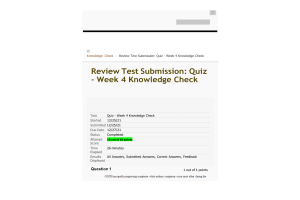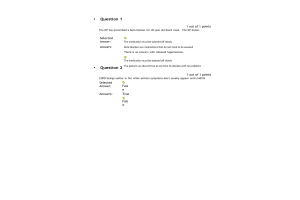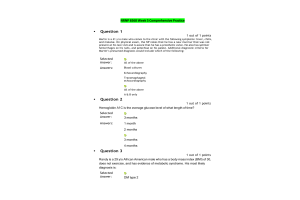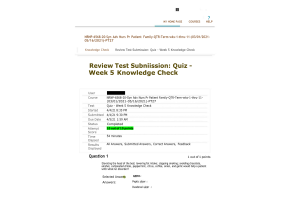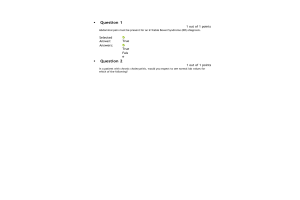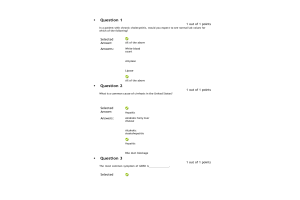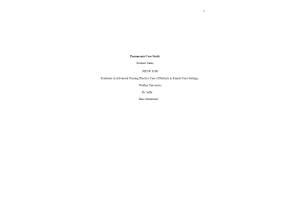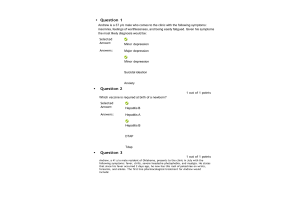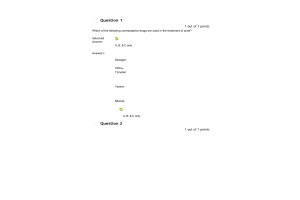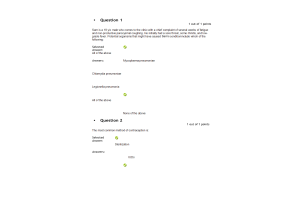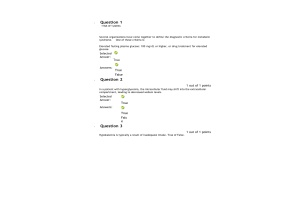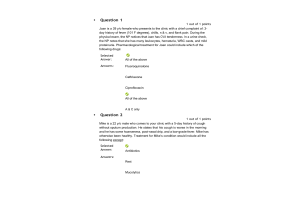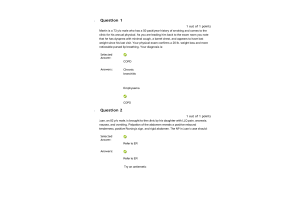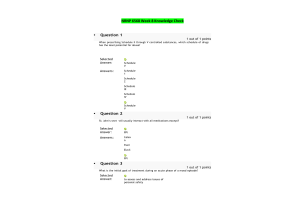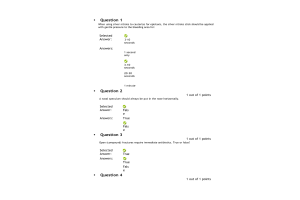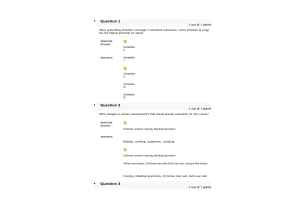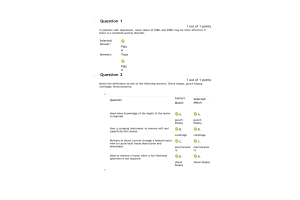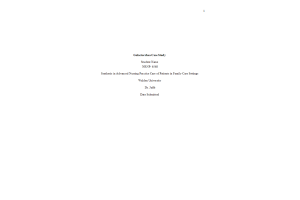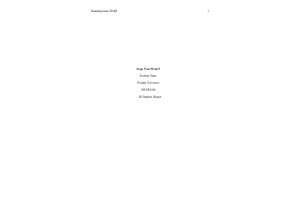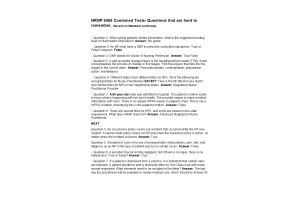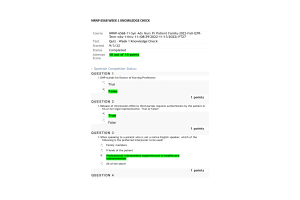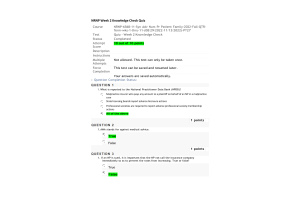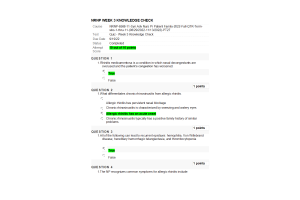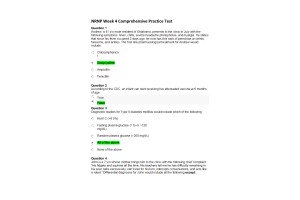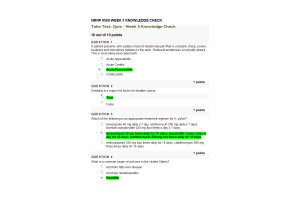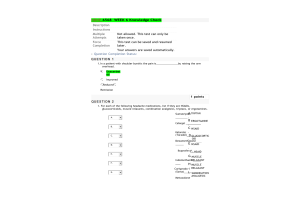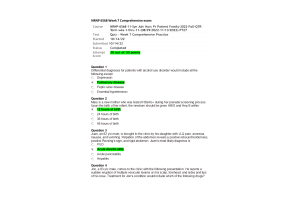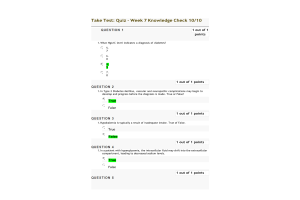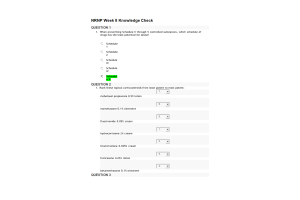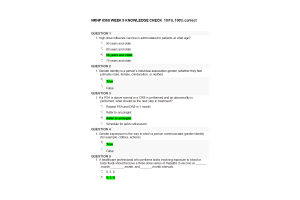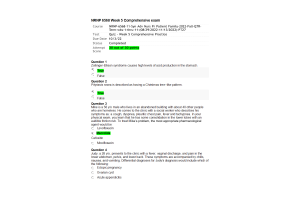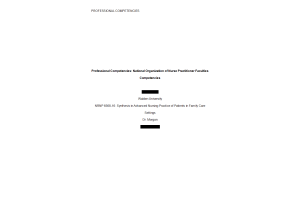NRNP 6568 Week 2 Assignment; Practice Exam Questions
- $55.00
- Question: Which of the following findings is associated with thyroid hypofunction?
- Question: A 14-year-old boy is brought in by his mother who reports that her son has been complaining for several months of recurrent bloating, stomach upset, and occasional loose stools. She reports that he has difficulty gaining weight and is short for his age. She has noticed that his symptoms are worse after eating large amounts of crackers, cookies, and breads. She denies seeing blood in the boy’s stool. Which of the following conditions is most likely?
- Question: A 67-year-old female patient presents with a 3-day-old cat bite that has become swollen, reddened, and painful to the touch. The nurse practitioner notes there is purulent discharge at the site of the bite. Which medication will the NP prescribe?
- Question: A 14-year-old girl with short stature, swollen hands and feet, and a webbed neck presents to the primary care clinic. Upon assessment she is found to be a Tanner state I. Which test will the NP order to confirm a diagnosis?
- Question: A 67-year-old woman with a 30-pack history of smoking presents for a routine annual physical exam. She complains of being easily SOB and is frequently fatigued. Physical exam reveals diminished breath sounds, hyperresonance, and hypertrophied respiratory accessory muscles. Her CBC results reveal that her HCT level is elevated. her pulmonary function test results show increased total lung capacity. Which diagnosis is most likely?
- Question: An elderly male presents to the clinic for a routine examination. The NP notes multiple rough, scaly patches on the patient’s forearms and face, and the back of his ears. Which diagnosis is most likely?
- Question: The NP is assessing a 63-year-old male who has a history of IV drug use as a young adult. He presents with fatigue and nausea. Which screen will the NP recommend for this patient?
- Question: The NP is performing an assessment of a 6-month-old child. What motor skills are expected at this stage?
- Question: The NP is managing a stable middle-aged adult with emphysema. In addition to reinforcing smoking cessation and medication schedules, which annual intervention will the NP recommend?
- Question: Pneumococcal conjugate vaccine (PCV13) (recommended for kids less than 2) 10.During a sports participation exam of a 14-year-old high school athlete, the NP notices a split of the S2 component of the heart sound during deep inspiration. She notes that it disappears upon expiration. The heart rate is regular, no murmurs are auscultated. Which of the following is correct?
- Question: Which finding will the nurse practitioner expect to see in a 13-year-old male patient with Cushing’s syndrome?
- Question: Which lifestyle factor is associated with secondary polycythemia vera?
- Question: Which test will CONFIRM the diagnosis of prostate cancer?
- Question: A 60-year-old female truck driver presents to the urgent care clinic of a hospital complaining of the worsening of her low back pain the past few days. Pain is accompanied by numbness in the perineal area. She describes the pain as “sharp and burning” and points to the left buttock. She reports that the pain started on the mid-buttock of the left leg and recently started to go down the lateral aspect of the leg toward the top of the foot. During PE, the ankle jerk and knee jerk reflex are 1+ on the affected leg and 2+ on the other leg. The pulses are the same bilat. Which of the following tests should the NP consider for this patient?
- Question: When assessing a patient using a Snellen chart, the NP records the visual acuity as 20/80. What does this assessment mean?
- Question: An obese 28-year-old female patient is seen in the office with acne, hirsutism, and oligomenorrhea. Blood drawn for a free androgen index (FAI) result is a 9.8 level. The DX is PCOS, which puts the patient at additional risk for which condition(s)?
- Question: A middle-aged hypertensive man presents with c/o an acute onset fever, chills, productive cough with rusty-colored sputum. c/o sharp pains on the left side of back and chest when coughing. T102.2°, HR 100, 130/80. UA negative. Consistent with?
- Question: During a physical exam, the NP palpates the RUQ while the patient takes a deep inspiration. Which diagnostic test is being performed?
- An elderly fair-skinned male presents to the clinic for a routine exam. The NP notices a lesion on the nose. The lesion is small, translucent papule with a central ulceration, telangiectasis, and rolled borders. Which is likely DX?
- Question: A cauliflower-like growth with foul-smelling discharge is seen during an otoscopic exam of the left ear in an 8-year-old boy with history of chronic OM. The TM and ossicles are not visible, and the patient seems to have difficulty hearing the NPs instructions. Which condition is most likely?
- Question: An elderly patient presents with a new onset of sleepiness, weight gain of 10 lbs. in a month, xerosis, and anomia. The patient’s labs: free T4 is 7.8 mcg/dL, TSH of 6.2mU/L, and a score of 28 on the MMSE. Which medication will the NP prescribe?
- Question: Which of the SSRIs is most likely to cause ED?
- Question: A 74-year-old male patient presents with an acute onset unilateral headache with a reddened and indurated temple. The patient is at risk for?
- Question: Upon auscultation of a 6-year-old patient, the nurse practitioner hears a systolic murmur that sounds like a musical vibration and becomes louder in the supine position. The murmur is a Grade I/II in intensity with minimal radiation. The NP will?
- Question: All of the following would require the NP to delay testing a patient’s PSA, except:
- Question: While performing a newborn assessment, the NP notes discharge, swelling, and redness on one of the infant’s lacrimal ducts. The mother reports crusting on the infant’s eyes. Which DX is most likely?
- Question: During the PE of a 60-year-old adult, the NP performs an abdominal exam. The NP is checking the LUQ of the abdomen. During percussion, an area of dullness is noted beneath the lower left ribcage. Which of the following is a true statement regarding the spleen?
- Question: An elderly male resident in a LTF has suddenly developed a fever of 102.3° and c/o chills and pain that radiates from the perineal area to the rectum and back. The prostate is extremely tender, warm, and boggy upon DRE. UA reveals pyuria and hematuria. Which DX is most likely?
- Question: A young adult with myasthenia gravis is diagnosed with pertussis. Which antibiotic is contraindicated in a patient with this condition?
- Question: The NP who is evaluating a patient with polycystic kidney disease will pay close attention to which area of the kidney?
- Question: Heberden’s nodes are commonly found in which of the following diseases?
- Question: Which of the following is a contraindication of the influenza vaccination?
- Question: A newly retired 60-year-old patient presents with BMI of 32 and a waist circumference of 41 inches. his lipid panel shows total cholesterol of 200 mg/dL, high-density lipo-protein (HDL) of 35 mg/dL, and triglycerides of 175 mg/dL. His BP is 124/70 mmHg. All of the following findings put the patient at risk for CVD, except?
- Question: A NP sees a pregnant woman for an evaluation of STDs. Assessment reveals FitzHugh-Curtis syndrome with swollen, tender joints. The NP will:
- Question: A 46-year-old male patient presents at the urgent clinic with swollen lower right leg that is reddened and tender to the touch. The patient reports no recent injury; however, he notes that yesterday he returned from a cross-country business trip. The NP will:
- Question: Which condition is associated with the findings in this radiograph?
- Question: A 68-year-old female presents to the clinic c/o increasing mid-back pain. Her past medical history is significant for treatment of GERD and a vertebral compression FX at T11 one year ago. An x-ray obtained during the encounter reveals a new vertebral FX at T12. Lab work reveals elevated serum alkaline phosphatase. The NP notes a 1-inch decrease in the patient’s height from the previous year. Which medication will the NP prescribe?
- Question: A 45-year-old patient presents to the clinic with c/o chills, fever, and malaise. Clinical findings show nontender red spots on the palms of both hands and soles of the feet. Splinter hemorrhages on the nail beds are also noted. The NP suspects which of the following conditions?
- Question: A 4-year-old boy diagnosed withs acute OM return in 48 hours with a possible rupture of the TM of the right ear. The mother reports seeing pus and a small amount of blood on the pillow that morning. The child states that his ear is no longer painful. During the ear exam, the otoscope is used to visualize the TM, which has a perforation on the lower edge that is draining a small amount of purulent discharge. All of the following topical ear medications should be avoided in patients with perforation of the TM, except:
- Question: A possible side effect from the use of nifedipine (Procardia XL) is:
- Question: The NP is discussing TCN with a young sexually active female patient being treated for bacterial sinus infection. The NP will advise the patient to:
- Question: A 25-year-old male presents to the clinic with a low-grade fever and single eschar on his back. He c/o burning at the site and states, “the area was white, then red. Now there is a red spot in the center.” The patient notes that he traveled to the Southeast for a camping trip. Which diagnosis is most likely?
- Question: The NP is evaluating a middle-aged woman who has experienced gradual weight gain lack of energy, dry hair, and irregular period for the past 8 months. Routine annual laboratory testing showed a TSH level of 10 mU/L. The NP decides to order a thyroid profile. Results show that TSH is 8.50 mU/L and serum freeT4 is decreased. During the PE, the patient’s BMI is 28. The heart and lung exams are both normal. Which of the following is the best treatment plan for this patient?
- Question: All of the following findings are considered benign lesions of the skin, except:
- Question: Which skin condition produces “honey-crusted”, pruritic vesiculopustules that rupture and crust?
- Question: A patient is diagnosed with Bell’s Palsy and prescribed high-dose steroids for 10 days, with minimal improvement. During a F/U visit, the NP suspects the patient has HSV-1. Which medication will the nurse practitioner prescribe?
- Question: A 6-year-old child with a history of rheumatic fever is being examined by the NP in a F/U after hospitalization. Auscultation of the heart reveals a loud blowing, highpitched murmur radiating to the axilla. Which DX is most likely?
- Question: A 29-year-old female patient presents to the clinic with complaints of painful sexual intercourse and pain when urinating. The patient’s temperature is 100.1°F. Upon PE, the NP notes a healthy appearance of the internal and external genitalia. The patient has lower abdominal and CMT tenderness in response to palpation. What will the NP order to confirm a diagnosis and determine the appropriate treatment?
- Question: An elderly female is DX with tic douloureux. Which assessment finding is related to Type 1?
- Question: An 11-year-old male presents with lower right-sided abdominal pain, an elevated temperature, and a WBC count of 17,000. He c/o N/V over several days. The NP flexes his right leg at this hip and knee, which results in moderate discomfort. Which DX is most likely?
- Question: The NP is reviewing the chart of an 8-month-old infant scheduled to receive immunizations. Which vaccination would the NP question if noted in the infant’s chart?
- Question: A 56-year-old patient presents to the clinic with reports of right hip pain that worsens after activity, decreased ROM of the right hip, and difficulty getting up after sitting for long periods. The NP hears crepitus in the right hip upon movement. Which condition is most likely?
- Question: The NP refers a 12-year-old boy with a swollen, red scrotum and ascending testicle to the ED with a diagnosis of testicular torsion. Which additional objective finding led the NP to this diagnosis?
- Question: Which of the following warning sign for scoliosis?
- Question: A nursing resident reports that his previous roommate was recently started on TB treatment. A Mantoux test and CXR are ordered for the patient. What is the minimum size of induration considered positive for this patient?
- Question: The NP is treating an elderly female patient withs recurrent depression. The patient refuses to take her medication. The patient’s daughter states, “she seems worse than ever. What should we do?”
- Question: An elderly patient is diagnosed with UTI. Which drug class may put this patient at risk for an Achilles tendon rupture?
- Question: Which statement will the NP make when discussing prostate cancer screening with a 65-year-old AA patient?
- A 32-year-old sexually active female is diagnosed with BV based on findings of copious milk like vaginal discharge. Speculum exam reveals gray/white discharge on the vaginal walls and fishlike odor based on the whiff test. The patient will be treated with a 5-day course of metronidazole vaginal gel, one application at bedtime, and advised to do which of the following:
- Question: A 78-year-old woman’s dual-energy X-ray absorptiometry (DEXA) scan yields a Tscore of -2.8. Which of the following pharmacological options preferred for treating this condition?
- Question: An 18-year-old female patient is being followed up for acne by the NP. During the facial exam, papules and pustules are noted mostly on the forehead and the chin areas. The patient has been using over-the-counter topical antibiotic gels and medicated soap daily for 6 months without much improvement. The NP will recommend:
- Question: Which hemopoietic disorder will the NP assess for in a 3-year-old child with lead poisoning?
- Question: A patient has been taking albuterol via a metered-dose inhaler for a month and remain in the yellow zone. Which of the following statements is true?
- Question: Upon examination of a 26-year-old patient, the NP finds elongated papilla of the lateral aspects on the patient’s tongue. how will the NP document this finding?
- Question: A patient presents with a new onset jaundiced sclera, right upper quadrant tenderness, and anorexia. The NP draws labs with the following results: AST =24 mg/dL; ALT = 13 mg/dL; HbsAg = negative; anti-HBc = negative; anti-HBs = positive. How will the NP interpret these data?
- Question: Which of the following laboratory tests is the most sensitive test for evaluating an active H. pylori infection of the stomach or duodenum?
- Question: A male patient presents with reports of urethritis, migratory arthritis in the large joints, and ulcers on the glans penis secondary to a chlamydial infection. The NP will implement all of the following interventions, EXCEPT:
- Question: A pediatric patient uses a sliding scale in conjunction with a long-acting insulin to manage type I diabetes. Which insulin should the patient prepare for an elevated BS between breakfast and lunch?
- Question: The NP is performing a vision screening on a newborn. Which finding would prompt a referral to a pediatric ophthalmologist?
- Question: A 72-year-old female patient has a complicated urinary tract infection. Which regimen will the NP prescribe?
- Question: Which mineral lab finding is deficient in a patient presenting with lethargy, weight gain, bradycardia, and a goiter?
- Question: What is the least common pathogen found in community-acquired atypical pneumonia?
- Question: The NP will monitor for all of the following side effects in a patient taking hydrochlorothiazide, except?
- Question: A patient newly diagnosed with DM has a BMI of 32.5, creatinine of 1.4 mg/dL, BUN of 20.2 mg/dL, and a fasting BS of 186 mg/dL. This patient also has a history of bladder cancer. Which is the most appropriate drug class for this patient?
- Question: An elderly patient is diagnosed with herpes zoster opthalmicus. Which cranial nerve is infected with this disorder?
- Question: A patient presents to the primary care clinic with a sudden onset of headache, sore throat and cough, wheezing, and a temperature of 100.6°F. The NP auscultates rhonchi and crackles, in addition to wheezing. A chest x-ray shows patchy infiltrates. The patient received antibiotics 2 months prior for strep throat. What is the appropriate treatment for this patient?
- Question: The NP has confirmed a diagnosis of acute hepatitis C in a patient. The NP is required to do which of the following?
- Question: Following a routine annual exam of a 59-year-old post-menopausal patient, the NP refers the patient to a gynecologist, who then orders a pelvic/intravaginal US. Which finding on the exam most likely prompted the referral and subsequent order?
- Question: A high school football player suffered a deceleration pivoting injury of his left knee during a game. He states he felt a sudden “pop” with subsequent swelling and the knee seemed to buckle. The NP will:
- Question: Which diagnostic test is used to confirm a diagnosis of vaginal candida infection?
- Question: A 65-year-old woman who has had type @ DM for 20 years is concerned about her kidneys. She has a history of 3 UTIs within the past 8 months but is currently asymptomatic. The NP will:
- Question: Which of the following is associated with male aging?
- Question: An underweight 15-year-old female cross-country runner presents with a complaint of progressive bilateral leg pain for 5-6 weeks. Upon examination, the NP notes inflammation in the left tibial area and that the patient has pes planus. Patient history reveals amenorrhea for 1 year. Which diagnosis is most likely?
- Question: Which lab results suggest a diagnosis of hypothyroidism?
- Question: The NP is caring for a 4-year-old patient with sickle cell disease who is experiencing a febrile illness. Which hemopoietic laboratory value will the NP use to evaluate the efficiency of the patient’s bone marrow response?
- Question: When examining a preschool child, the NP notes wheezing and diffused crackles upon auscultation of the lungs. Throat examination appears erythematous without pus or exudate. Respirations are 24 and Temp is 99.2°F. The mother states the child has been coughing for several weeks. CXR shows diffuse interstitial infiltrates. The NP orders all of the following, except:
- Question: A woman who was recently diagnosed with lupus complains that her hands and feet always feel cold, even in the summertime. Sometimes her fingertips become numb and turn blue color. The fingertips eventually turn dark red in color. Which of the following is most likely?
- Question: A thrill initially presents at which grade level of a heart murmur?
- Question: The NP is educating a 72-year-old patient with a history of ulcerative colitis regarding screening for colon cancer. The patient reports fatigue and frequent blood stools. Based on the patient’s assessment and history, what diagnostic testing should be performed annually for this patient?
- Question: A patient has several well-defined, primary lesions less than 20 mm over the trunk and extremities. After completing a dermascopic exam, the NP diagnoses Bowen’s disease. Which treatment will the NP recommend?
- Question: A 5-year-old child is assessed for dysuria and frequency. Which antibiotic would the NP prescribe upon finding the urine culture positive for gram-negative bacteria?
- Question: A patient presents with a wedge-shaped, superficial, yellow, triangular masses on the nasal side of the left eye. The patient denies pain or vision changes. PERRLA is normal. Which diagnosis is most likely?
- Question: A toddler who was born prematurely is being assessed for hearing loss. Which assessment finding is a high-risk factor for hearing loss?
- Question: What are USPDTF recommended guidelines for breast cancer screening?
- Question: What is the priority treatment for a patient who presents with an asthma exacerbation?
- Question: The NP is screening a 1-week-old newborn for congenital heart defects (CHDs) and measures 91% oxygenation in the right hand and 95% in the left hand. The NP will:
- Question: Which of the following findings is most likely in young primigravidas with pregnancy-induced hypertension (PIH)?
- Question: While reviewing lab results for a patient with suspected recreational drug abuse, the NP notes an elevated BUN level. Which additional test will the NP order to confirm or rule out renal failure in this patient?
- Question: All of the following are known to cause chronic cough, except:
- Question: Which assessment finding is associated with a diagnosis of proximal hypospadias?
